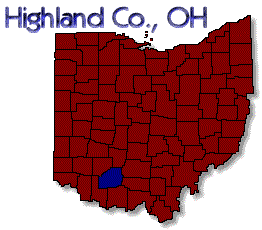PRESS-GAZETTE...Hillsboro, Ohio, Friday, March 18, 1938
OCTAGON-SHAPED SCHOOL HOUSE WAS WIDELY USED..
Sinking Sspring Structure Community Center for Many Years; Taxpayer Refused to
Help Pay for it. .....by..Violet Morgan
Sketches of the history of Sinking Spring and vicinity would not be complete were
tribute not paid in passing to the odd eight-cornered building around which the life
of a pioneer community was once centered. This octagon building sits on a corner of
the town's public square, on the picturesque old Zane trace (SR 41).
Jacob Hiestand, Sr., owner of the large acreage in which the town sprang up, is the
great great grandfather of Miss Mary Cowman of Hillsboro. He was a noted water
Witcher. Using a forked, peach-tree branch called a water witch, he had the uncanny
power of being able to locate water as he walked about the land, holding to both
prongs by his hands as he pointed the stem towards the earth. The stick would turn in
his hand when he was near water. It was he who located water sources in and around
sinking Spring where today are many pumps.
There were 98-voters in Brushcreek township in 1807. This was just 12 years after
the first settler, John Wilcoxon, arrived to be known thereafter as Highland country's
first settler, John Wilcoxon, arrived to be known thereafter as Highland county's first
settler. following him in 1796 were Timothy Marson and Frederick Braucher, Henry
Countryman, who built the first water mill on East Fork Brushcreek settled here
about 1803, and Simon Shoemaker, who had become a citizen of the township in
1802, built a water mill on the same stream in 1806.
Many well-known names are connected with Sinking Spring's early history. Among
them are found such names as, McKeehan, Hiestand, East, Gall, McClure Frankl9in,
Byrd, Belleson, Hite, Butler, McClellan, Moorhead, Patton, Easton and Leighton.
Jacob Hiestand, who platted, recorded and named Sinking Spring, Middletown,
November 27, 1815, and donated the public square to the town, was convinced that
the town would become the county seat of a new county of the Northwest Territory
and that a court house would grace the square. This dream never materalized and Mr.
Hiestand, discouraged because church members thought his enterprise anti-Christian,
abandoned his plans and sold the land to his son, Joseph Hiestand, Sr., and Allen
Guilford who completed the work.
The first school, a crude log cabin, was built on the Square by the side of the site of
the octagon building between 1810 and 1820, with Jesse Dewey and John
Wickerham among its first teachers. About 1831, when the township was divided
into school districts, it was decided to build a more modern school, hen=ce the
octagon brick structure. Why the queer from was chosen is not known. One German
farmer refused to pay the tax levied upon the district for it because, he said, it was
nothing but an ugly old smoke house.
The octagon school flourished until about 1845 when it was abandoned for school
purposes because of its inadequate size and because it stood on public ground.
In 1844 a two-story brick building was build on the east side of Main street, but as it
was not centrally located, it was sold to Isaac East for a residence. This is still one of
the prettiest residences in town.
Soon afterwards a frame building was built on Grand street and two teachers were
employed. The next, and latest building to be erected, is the modern grade and high
school building which was erected a few years ago.
In the meanwhile the octagon school building was used as a place for council and
civic meetings and court room for trials held by the justice of the peace. It also
served as the Sinking Spring high school for several years preceding the building of
the latest school.
] Many important persons acquired their educations in the tiny, unimposing school
and went out into the world to make names for themselves. It is said that "all things
pass" but the octagon school resisting the onslaught of the years, has survived to
stand, a symbol of its founders' hopes and dreams,--a monument to the patients
endeavor of those who have gone before.

